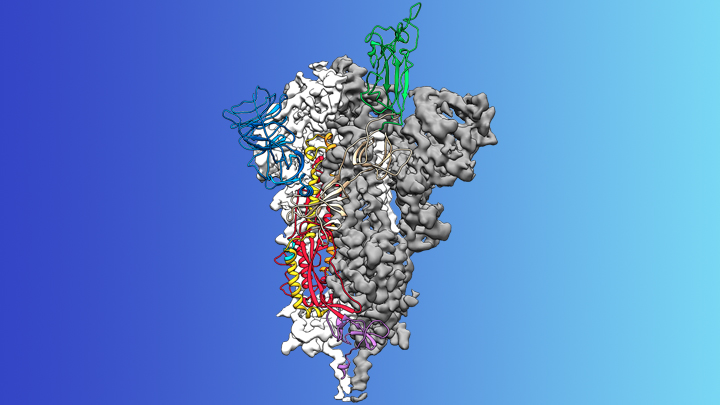
When the COVID-19 pandemic was first recognized for the threat that it is, researchers scrambled to find anything that might block the virus' spread. While vaccines have grabbed much of the attention lately, there was also the hope that we could develop a therapy that would block the worst effects of the virus. Most of these have been extremely practical: identify enzymes that are essential for the virus to replicate, and test drugs that block similar enzymes from other viruses. These drugs are designed to be relatively easy to store and administer and, in some cases, have already been tested for safety in humans, making them reasonable choices for getting something ready for use quickly.
But the tools we've developed in biotechnology allow us to do some far less practical things, and a paper released today describes how they can be put to use to inactivate SARS-CoV-2. This is in no way a route to a practical therapy, but it does provide a fantastic window into what we can accomplish by manipulating biology.
Throw it in the trash
The whole effort described in the new paper is focused on a simple idea: if you figure out how to wreck one of the virus' key proteins, it won't be able to infect anything. And, conveniently, our cells have a system for destroying proteins, since that's often a useful thing to do. In some cases, the proteins that are destroyed are damaged; in others, the proteins are made and destroyed at elevated paces to allow the cell to respond to changing conditions rapidly. In a few cases, changes in the environment or the activation of signaling pathways can trigger widespread protein destruction, allowing the cell to quickly alter its behavior.
This system relies on a small protein called "ubiquitin." When a protein is to be targeted for destruction, enzymes called ubiquitin ligases chemically link a chain of ubiquitins to it. These serve as a tag that is recognized by enzymes that digest any proteins with ubiquitin attached to them.
So, the idea behind the new work is to identify a key viral protein, and figure out how to attach ubiquitin to it. The cell would then take care of the rest, digesting the viral protein and thus blocking the production of any useful viruses in that cell. In this case, the researchers decided to target the spike protein that sits on the surface of coronaviruses and allows them to attach to and infect new cells.
Unfortunately, there are no proteins that attach ubiquitin to the viral spike protein. Or, rather, there were no proteins that fit that description.
But a team at Harvard has now produced one.
Bioengineering
The team's method of doing so started with the fact that we do know something that sticks to the viral spike protein: the cellular protein it latches on to in order to enter the cell. This is called the angiotensin-converting enzyme 2, or ACE2, but we'll call it the green protein because that's the color we use in this diagram. The idea was to find a part of this protein that stuck to spike (aka the red protein) and link that to a ubiquitin-adding protein (blue). Seems simple enough.

But there's a complication: the green protein also sticks to other proteins found on healthy, uninfected cells. So, if you're not careful, your virus-destroying enzyme will also end up destroying proteins that are essential to the health of uninfected cells. Which would be a rather large "oopsie."
To solve this problem, the researchers downloaded the data that showed the atomic-level details of the structure of the red and green proteins, as well as how those proteins interact. (Yes, it's available.) Then they transferred this data into a software package that finds the most energetically favored interactions between proteins. (Yes, those exist.) They they asked the program to virtually slice the green protein up and find smaller pieces that satisfied two conditions: the pieces stuck to the virus' red protein but not to the one found on the surface of healthy human cells.
With a red-specific bit of the green protein identified, the researchers fused it to something that stuck to the blue protein, which would link ubiquitin to the red one. This hybrid would act as a bridge, linking the viral red protein to a blue one that would attach ubiquitin to it.

This worked, but not especially well. The authors linked spike (the red one) to a fluorescent protein and found out that producing their hybrid protein dropped the fluorescence by about 30 percent. Better than nothing—but not great.
Optimization
So, how to make it better? The researchers used the software package to make mutations at every single location in their green protein fragment, and they checked what each one did for its affinity for the viral spike protein. Anything that looked promising, they engineered into the actual protein. One of these boosted the performance considerably; now, instead of lowering the fluorescence by 30 percent, it dropped by 50 percent.
But that wasn't the end of their efforts. They green fragment/linker hybrid they built served as a bridge by sticking to both the red protein and the ubiquitin-attaching blue one. To boost the efficiency further, the researchers simplified things a bit by directly connecting the blue enzyme to the green fragment. With that in place, there's a direct link between the protein the red one sticks to and the blue one that ensures its destruction. This cut the amount of fluorescent spike protein present in cells by 60 percent.
So, an amazing application of biotechnology, right? Unfortunately, it's also likely to be absolutely useless, and not just because we don't know whether a 60 percent reduction is meaningful. For this to be effective, it would have to be made by cells as they have active infections. Which means we have to insert the gene that encodes the protein they built into cells, at least temporarily. We can definitely do that—it's technology some of the leading vaccine candidates rely on. But to get a vaccine to work, we don't need to get a gene active in that many cells. To protect an entire organ, we might.
The conclusion: this is likely to be a non-starter, especially given that there are promising vaccines and many other potential therapies ahead of it in the pipeline for safety testing. Still, the things that make this sort of technology wildly impractical for use to treat humans for a virus may not apply to other use cases like bacteria, crops, animals, or even less urgent medical needs. So, while the details of this work aren't really significant, the fact that we've developed all the underlying technology needed for it is worth keeping in mind.
Communications Biology, 2020. DOI: 10.1038/s42003-020-01470-7 (About DOIs).
"Idea" - Google News
November 29, 2020 at 12:06AM
https://ift.tt/33nlyhq
A mildly insane idea for disabling the coronavirus - Ars Technica
"Idea" - Google News
https://ift.tt/2VWDFI5
https://ift.tt/3d3vX4n
Bagikan Berita Ini














0 Response to "A mildly insane idea for disabling the coronavirus - Ars Technica"
Post a Comment